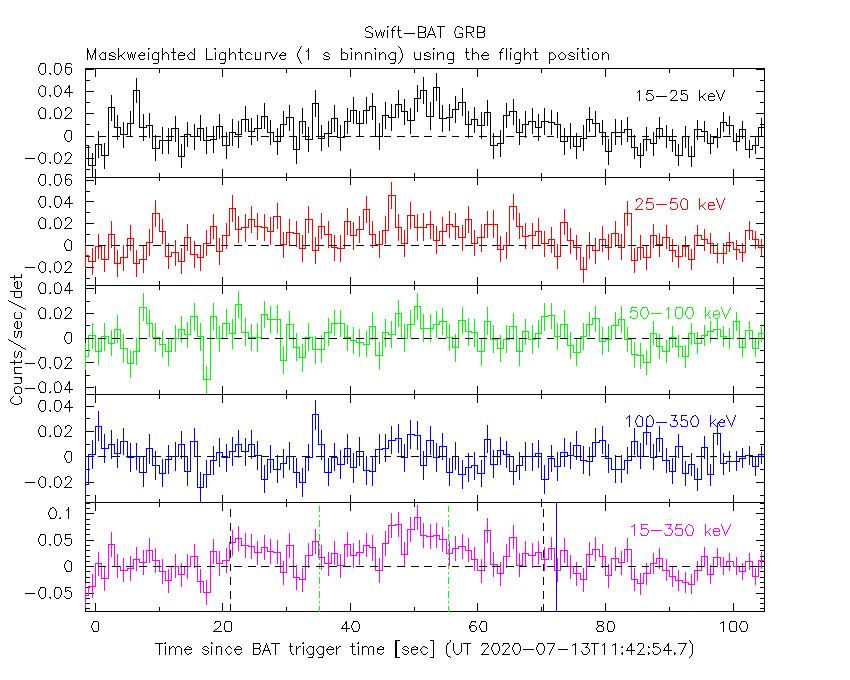
A.Y. Lien (GSFC/UMBC) and M. Perri (ASDC) for the Swift team
At 11:42:54 UT, the Swift Burst Alert Telescope (BAT) triggered and located GRB 200713A (trigger=982201) (Lien et al. GCN Circ. 28088). Swift slewed immediately to the burst. At the time of the trigger, the initial BAT position was 65° from the Sun (2.4 hours West) and 62° from the 45%-illuminated Moon. Table 1 contains the best reported positions from Swift, and the latest XRT position can be viewed at http://www.swift.ac.uk/xrt_positions.
Table 2 is a summary of GCN Circulars about this GRB from observatories other than Swift.
Standard analysis products for this burst are available at https://gcn.gsfc.nasa.gov/swift_gnd_ana.html.
As reported by Ukwatta et al. (GCN Circ. 28096),
the BAT ground-calculated position is RA, Dec = 76.941, -32.846 deg which is RA(J2000) = 0
The mask-weighted light curve (Figure 1) shows several weak overlapping pulses that start at ~T+20 s and end at ~T+80 s.
The time-averaged spectrum from T+18.45 to T+74.94 s is best fit by a simple power-law model.
The power law index of the time-averaged spectrum is 2.48 ± 0.32.
The fluence in the 15-150 keV band is 9.0 ± 1.6 x 1
The results of the batgrbproduct analysis are available at https://gcn.gsfc.nasa.gov/notices_s/982201/BA/.
Analysis of the initial XRT data was reported by Perri et al. (GCN Circ. 28092). We have analysed 11 ks of XRT data for GRB 200713A, from 156 s to 124.4 ks after the BAT trigger. The data comprise 139 s in Windowed Timing (WT) mode with the remainder in Photon Counting (PC) mode. The enhanced XRT position for this burst was given by Evans et al. (GCN Circ. 28089).
The light curve (Figure 2) can be modelled with an initial power-law decay with an index of α=0.28 (+0.08, -0.10), followed by a break at T+11.6 ks to an α of 0.98 ± 0.12.
A spectrum formed from the WT mode data can be fitted with an absorbed power-law with a photon spectral index of 3.71 (+0.26, -0.24). The best-fitting absorption column is 3.2 ± 0.5 x 1
A summary of the PC-mode spectrum is thus:
Total column: 1.7 ± 0.5 x 1
Galactic foreground: 2.0 x 1
Excess significance: 5.0 σ
Photon index: 2.13 (+0.18, -0.17)
The results of the XRT team automatic analysis are available at http://www.swift.ac.uk/xrt_products/00982201.
UVOT results are not available.

Figure 1. The BAT
mask-weighted light curve in the four individual and total
energy bands. The units are counts

Figure 2. The XRT light curve.
Any data from a crosshatched region are not included in the fit.
| RA (J2000) | Dec (J2000) | Error | Note | Reference |
|---|---|---|---|---|
| 0 |
-32°48'53.2" | 1.5" | XRT-final | UKSSDC |
| 0 |
-32°48'53.1" | 2.1" | XRT-enhanced | Evans et al. GCN Circ. 28089 |
| 0 |
-32°50'47.1" | 2.8' | BAT-refined | Ukwatta et al. GCN Circ. 28096 |
| Band | Authors | GCN Circ. | Subject | Observatory | Notes |
|---|
July 15, 2020